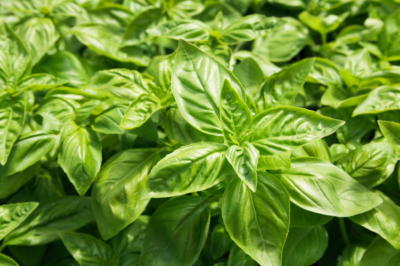Considering its tropical origin, the growth criteria for basil in the local latitudes are clearly defined. The following overview presents the essential framework conditions:
Basil (Ocimum basilicum) is a popular herb known for its aromatic leaves and its use in a variety of culinary dishes. To grow basil successfully, it’s essential to provide the right conditions.
Here’s what basil needs to thrive:
1. Sunlight:
- Basil thrives in full sun, which means it needs at least 6-8 hours of direct sunlight each day. It can tolerate some light shade, but full sun is ideal for robust growth.
2. Temperature:
- Basil is sensitive to cold temperatures and frost. It grows best in warm to hot conditions, with temperatures between 70-95°F (21-35°C). It’s crucial to protect basil from cold snaps.
3. Soil:
- Well-draining, nutrient-rich soil is essential for basil. A loamy or sandy soil with a slightly acidic to neutral pH (around 6.0-7.0) is ideal. Good drainage prevents waterlogged roots.
4. Watering:
- Basil prefers consistent moisture. Water when the top inch of soil feels dry. Be careful not to overwater, as basil is susceptible to root rot. Water at the base of the plant to keep the foliage dry and reduce the risk of disease.
5. Pruning and Harvesting:
- Regularly prune or harvest basil leaves to encourage bushier growth and prevent flowering. Flowering can make the leaves less flavorful.
6. Spacing:
- Plant basil 12-18 inches apart to allow air circulation and reduce the risk of disease. Proper spacing also ensures that each plant has room to grow.
7. Fertilization:
- Basil benefits from periodic feeding. You can use a balanced, all-purpose fertilizer or one specifically designed for herbs. Follow the recommended application rates on the fertilizer label.
8. Companion Plants:
- Basil is known to deter some pests and can be a beneficial companion plant. It pairs well with tomatoes, peppers, and oregano, among others.
9. Pest and Disease Control:
- Keep an eye out for common basil pests like aphids and whiteflies. Using natural methods or organic pest control can help manage infestations. Ensure good air circulation and proper spacing to reduce the risk of fungal diseases.
10. Container Gardening:
- If you have limited garden space, basil grows well in containers. Use a high-quality potting mix and ensure the pot has drainage holes. Container-grown basil may require more frequent watering.
11. Pruning Flowers:
- Basil tends to flower as it matures. To encourage the plant to focus on leaf production, regularly pinch off or prune the flower buds as they appear.
12. Overwintering:
- Basil is an annual, but you can overwinter it indoors. Before the first frost, take cuttings to root in water or transplant a potted basil plant indoors, providing it with enough light and warmth.
By providing these optimal conditions, you can enjoy a bountiful harvest of fresh, fragrant basil leaves for your culinary creations. Whether you’re growing basil in a garden bed or in a pot on your windowsill, these guidelines will help you cultivate healthy and flavorful basil plants.

- Basil seeds, being light germinators, must not be covered with substrate
- seedlings grow only at temperatures of 20 to 25 degrees
- young plants thrive in the open only from a minimum temperature of 15 degrees Celsius
- as a heavy grower, a nutrient-rich soil in a sunny location is important for vital growth
- Regia stops growing at temperatures below 10 degrees Celsius.
If the wintering of perennial basil varieties is to succeed, they are put away in time before the first frost. Winter growth takes place only in a sunny window place at 18-22 degrees or higher.

